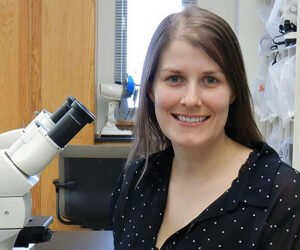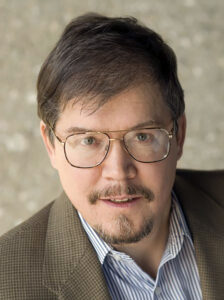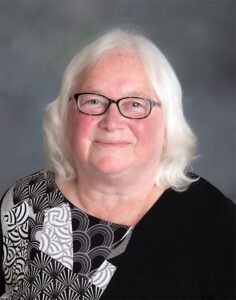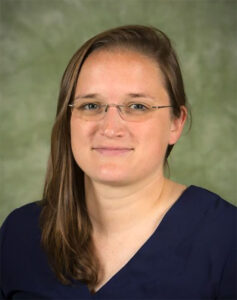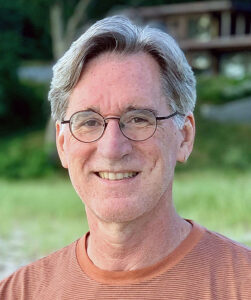For more than 30 years, the Ocean Discovery Lecture Series (formerly the Distinguished Lecturer Series) has brought the remarkable scientific results and discoveries of the International Ocean Discovery Program and its predecessor programs to academic research institutions, museums, and aquaria. Since 1991, more than 1,000 presentations to diverse audiences have been made through the Lecture Series.
The Ocean Discovery Lecturers for the 2025-2026 academic year are:
MAGNETIC FORENSICS IN THE SCOTIA SEA: EXPLORING THE DEEP SEA MAGNETIC SUSCEPTIBILITY-ICE CORE DUST CONNECTION
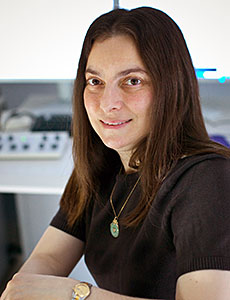 For more than 50 years, international collaborative scientific ocean drilling programs have recovered long sedimentary records from the world’s oceans that serve as recorders of Earth’s complex history. Scientific ocean drilling records have advanced understanding of Earth’s climate and the interconnectedness of its wind systems, ocean currents, and ice sheets. A decades-old puzzle concerns the cause of the striking similarity between late Pleistocene sedimentary magnetic susceptibility records from the Scotia Sea, Southern Ocean, recovered from 3700m below sea level, and atmospheric dust flux records constructed from East Antarctic ice cores recovered from 2900m above sea level. The Scotia Sea is down-wind of a modern dust plume emanating from southern South America, and Patagonia has been geochemically fingerprinted as the source of Late Pleistocene dust in East Antarctic ice cores. However, dust is typically a minor contribution to marine sediment and may not be voluminous enough to drive the susceptibility signal of glacial-marine sediments. Here we present results from International Ocean Discovery Program Expedition 382 to “Iceberg Alley” in the Scotia Sea. In this presentation, I examine time slices across the Pleistocene to conduct “magnetic forensics” by characterizing the magnetic mineral assemblages responsible for the Scotia Sea magnetic susceptibility signal, and compare these with magnetic provenance data from glacial outwash in southern Patagonia and terrestrial and marine till and bedrock from the Antarctic Peninsula, West Antarctica, and East Antarctica. I explore the roles of Antarctic Ice Sheet grounding line locations, the sources of silt supplied to the Southern Ocean, and subsequent redistribution by deep ocean currents to understand linkages between the Antarctic Ice Sheet, southern westerly winds, the Antarctic Circumpolar Current, and Weddell Sea Gyre during the Pleistocene.
For more than 50 years, international collaborative scientific ocean drilling programs have recovered long sedimentary records from the world’s oceans that serve as recorders of Earth’s complex history. Scientific ocean drilling records have advanced understanding of Earth’s climate and the interconnectedness of its wind systems, ocean currents, and ice sheets. A decades-old puzzle concerns the cause of the striking similarity between late Pleistocene sedimentary magnetic susceptibility records from the Scotia Sea, Southern Ocean, recovered from 3700m below sea level, and atmospheric dust flux records constructed from East Antarctic ice cores recovered from 2900m above sea level. The Scotia Sea is down-wind of a modern dust plume emanating from southern South America, and Patagonia has been geochemically fingerprinted as the source of Late Pleistocene dust in East Antarctic ice cores. However, dust is typically a minor contribution to marine sediment and may not be voluminous enough to drive the susceptibility signal of glacial-marine sediments. Here we present results from International Ocean Discovery Program Expedition 382 to “Iceberg Alley” in the Scotia Sea. In this presentation, I examine time slices across the Pleistocene to conduct “magnetic forensics” by characterizing the magnetic mineral assemblages responsible for the Scotia Sea magnetic susceptibility signal, and compare these with magnetic provenance data from glacial outwash in southern Patagonia and terrestrial and marine till and bedrock from the Antarctic Peninsula, West Antarctica, and East Antarctica. I explore the roles of Antarctic Ice Sheet grounding line locations, the sources of silt supplied to the Southern Ocean, and subsequent redistribution by deep ocean currents to understand linkages between the Antarctic Ice Sheet, southern westerly winds, the Antarctic Circumpolar Current, and Weddell Sea Gyre during the Pleistocene.
Dr. Stefanie Brachfeld is the Vice Provost for Research at Montclair State University and a Professor in the Department of Earth and Environmental Studies. Dr. Brachfeld’s research expertise is in marine geology, Antarctic System Science, paleoclimatology, paleomagnetism, environmental magnetism, and planetary magnetism. She has participated in 11 marine geology and geophysics and paleoceanographic expeditions to Antarctica, the North Atlantic Ocean, and Arctic Ocean, including two expeditions aboard the JOIDES Resolution. Dr. Brachfeld has served as an invited member of advisory boards for multiple national facilities and programs including the Institute for Rock Magnetism, Antarctic Marine Geology Research Facility, U.S. Polar Rock Repository, Antarctic Research and Supply Vessel Scientific Advisory Committee, and the Polar Subcommittee of the Advisory Board to the NSF Geoscience Directorate. She currently chairs the Science Communication subcommittee of the U.S. Advisory Committee for Scientific Ocean Drilling (USAC). Dr. Brachfeld is especially proud of her 70+ Montclair State University student advisees who are now gainfully employed as environmental professionals, geoscientists, K-12 educators, education and outreach specialists, government employees, postdocs and research scientists, professors, and those pursuing advanced degrees.
MARINE TEPHRA RECORDS TELL BIG STORIES—HIGHLY EXPLOSIVE VOLCANISM AND RIFTING IN PARADISE (THE HELLENIC ARC, GREECE)
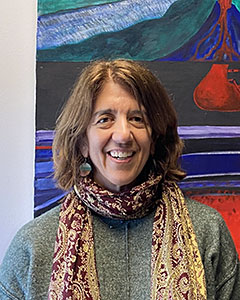 The Hellenic arc in Greece is the most active volcanic region in Europe, posing hazards that range from tephra fall to pyroclastic flows that travel across both the seafloor and the sea surface, and resulting tsunamis. The most famous eruption in the Christiana-Santorini-Kolumbo (CSK) volcanic field within this arc is the 1600 BCE caldera-forming eruption of Santorini that buried a thriving Bronze Age city and caused widespread tsunamis. The most recent explosive eruption is the ~400-year-old eruption of neighboring Kolumbo volcano, but islands within the Santorini caldera have erupted as recently as 1950. The CSK volcanic field sits within an active submarine extensional basin whose sediments preserve the entire tephra record of the arc since its initiation. IODP Expedition 398 sampled this uninterrupted record of volcanism at twelve sites within the volcanic field, providing an unprecedented opportunity to develop a robust record of hazardous events for volcanic risk assessment. We are also sampling the crystal cargo in particularly noteworthy tephra events to develop conceptual models for magma storage regions and eruption triggers, and how those have changed over time. The record is also being used to decipher long term links between volcanism and tectonics.
The Hellenic arc in Greece is the most active volcanic region in Europe, posing hazards that range from tephra fall to pyroclastic flows that travel across both the seafloor and the sea surface, and resulting tsunamis. The most famous eruption in the Christiana-Santorini-Kolumbo (CSK) volcanic field within this arc is the 1600 BCE caldera-forming eruption of Santorini that buried a thriving Bronze Age city and caused widespread tsunamis. The most recent explosive eruption is the ~400-year-old eruption of neighboring Kolumbo volcano, but islands within the Santorini caldera have erupted as recently as 1950. The CSK volcanic field sits within an active submarine extensional basin whose sediments preserve the entire tephra record of the arc since its initiation. IODP Expedition 398 sampled this uninterrupted record of volcanism at twelve sites within the volcanic field, providing an unprecedented opportunity to develop a robust record of hazardous events for volcanic risk assessment. We are also sampling the crystal cargo in particularly noteworthy tephra events to develop conceptual models for magma storage regions and eruption triggers, and how those have changed over time. The record is also being used to decipher long term links between volcanism and tectonics.
There are many exciting and sobering outcomes of Expedition 398, including the recognition of a previously unknown submarine explosive eruption of ancestral Santorini based on our sampling of giant offshore pumice deposits. This submarine deposit volume is six times bigger than the late Bronze Age Santorini eruption, the largest in the region. Pyroclastic flow deposits reached land 30km away. Another previously unknown tephra deposit within Santorini’s caldera provides evidence for an explosive eruption from Kameni volcano in 726 CE. Effusive eruptions from this caldera volcano are well known as recently as 75 years ago, but this VEI 5 eruption exceeds previously considered worst-case scenarios. Other notable expedition outcomes include good matches between seismic and petrologic models for Kolumbo volcano magma storage, the recognition of a far-traveled ash megabed originating from the Kos Plateau >120km away, and documented linkages between crustal faulting/rifting events and volcanism.
Dr. Susan DeBari is professor emerita in the Geology Department at Western Washington University. She received her B.A. in Geology from Cornell University and her Ph.D. from Stanford University. Susan started her geological career as a field geologist working on uplifted deep crustal sections of ancient volcanic arcs. Over the years, that research focus gradually shifted to the opposite end of the volcanic system, using eruptive products from active volcanoes to better understand hazards. Her current research focus is on the use of crystals carried by tephras and lavas from active volcanoes to decipher their subvolcanic architecture and eruption triggers. She began marine research over 30 years ago with dives into the Izu Bonin trench with the Shinkai submersible and was a co-proponent on several IODP drilling proposals in that arc system. She sailed on her first IODP expedition in 2014, and then again on the Hellenic arc expedition in 2022-23. She will highlight the impressive outcomes that can be fostered by the unique opportunity of multidisciplinary and international collaboration on an IODP research vessel.
STORIES OF COMMUNICATING SCIENTIFIC OCEAN DRILLING, FROM TEXT TO TEXTILES
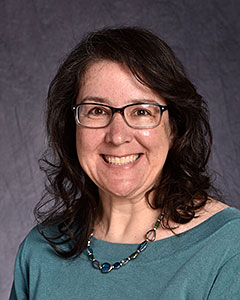 Starting with the very first scientific oceanographic research expedition, scientists in this field have been sharing their discoveries with wide-ranging audiences. Tales of adventures at sea are disseminated in the popular press (social media, magazines, books, etc.), while the completed analyses of deep-sea samples are published in scholarly reports and peer-reviewed journals. This presentation will highlight specific examples of how scientific ocean drilling expeditions have been shared from CUSS 1 (Project Mohole), Glomar Challenger, and JOIDES Resolution. A spotlight will be placed on DSDP Leg 3 from 1969, the expedition that provided the evidence for plate tectonics, and IODP Expedition 390, which visited the region just over 50 years later and on which I sailed in 2022 as an Onboard Outreach Officer.
Starting with the very first scientific oceanographic research expedition, scientists in this field have been sharing their discoveries with wide-ranging audiences. Tales of adventures at sea are disseminated in the popular press (social media, magazines, books, etc.), while the completed analyses of deep-sea samples are published in scholarly reports and peer-reviewed journals. This presentation will highlight specific examples of how scientific ocean drilling expeditions have been shared from CUSS 1 (Project Mohole), Glomar Challenger, and JOIDES Resolution. A spotlight will be placed on DSDP Leg 3 from 1969, the expedition that provided the evidence for plate tectonics, and IODP Expedition 390, which visited the region just over 50 years later and on which I sailed in 2022 as an Onboard Outreach Officer.
In addition to sharing the process of science at sea through social media, daily geospatial updates, blog posts, and Zoom sessions, I have continued disseminating stories post-expedition through audio narratives and the generation of a quilt collection that includes data visualizations and gamified tapestries. This presentation will include audio clips from scientists that sailed on early and more recent scientific ocean drilling expeditions, exemplifying their experiences with ship-to-shore communications and access to global news. Select quilts from the Stories of the South Atlantic (IODP Exp. 390) collection will also be showcased at the talk.
Distinguished Professor Laura Guertin holds a Ph.D. in Marine Geology & Geophysics from the University of Miami’s Rosenstiel School of Marine & Atmospheric Science and a B.A. in Geology from Bucknell University. She has served as an Earth Science faculty member at Penn State Brandywine since 2001, where she teaches introductory-level geoscience courses for non-STEM majors. Dr. Guertin has received funding from the EPA and has been a PI/co-PI on several NSF projects relating to geoscience education and outreach. Her teaching has been recognized with awards from the Geological Society of America and Association for Women Geoscientists. Other national recognitions include being named a Fellow of both the Geological Society of America and the American Association for the Advancement of Science, receiving a U.S. Senate Certificate of Special Recognition, and named as a U.S. Congressional Citation Honoree for her work in the area of civic and community engagement. In addition to sailing on two NOAA vessels and JOIDES Resolution, Dr. Guertin has a passion for sharing scientific research and the process of science with all audiences. Her science communication experiences include serving as the geoscience education and educational technology blogger with the American Geophysical Union for nine years, initiating and managing the growing scientific ocean drilling audio archive Tales from the Deep, and quilting science stories, including a 19-quilt collection from IODP Expedition 390 (https://www.sciodquilts.studio/).
RECONSTRUCTING EARLY CENOZOIC CLIMATE AND ATMOSPHERIC CO2 WITH BAYESIAN FORWARD PROXY SYSTEM MODELS
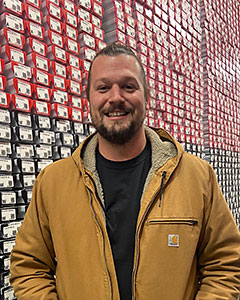 Sedimentary geologic archives reveal Earth underwent many episodes of long-term (millions of years) and short-term (thousands of years or less) warming throughout its geologic past. This includes a prominent interval in the relatively recent late Paleocene and early Eocene from approximately 59 to 50 Ma during which background surface temperatures rose gradually as Earth was peppered by abrupt warming events called hyperthermals. These events are associated with the release of 13C-depleted carbon to the ocean and atmosphere from sedimentary reservoirs and/or volcanism. Thus, hyperthermals including the largest of the interval, the Paleocene Eocene Thermal Maximum, or PETM, provide useful analogues for investigating climate and carbon cycle feedbacks and ground-truthing theory.
Sedimentary geologic archives reveal Earth underwent many episodes of long-term (millions of years) and short-term (thousands of years or less) warming throughout its geologic past. This includes a prominent interval in the relatively recent late Paleocene and early Eocene from approximately 59 to 50 Ma during which background surface temperatures rose gradually as Earth was peppered by abrupt warming events called hyperthermals. These events are associated with the release of 13C-depleted carbon to the ocean and atmosphere from sedimentary reservoirs and/or volcanism. Thus, hyperthermals including the largest of the interval, the Paleocene Eocene Thermal Maximum, or PETM, provide useful analogues for investigating climate and carbon cycle feedbacks and ground-truthing theory.
Geochemical proxy systems allow for the quantification of past environments, providing insights into the sensitivity of Earth’s surface conditions to past carbon release. Marine archives including biogenic carbonate and organic carbon fossils provide perhaps the most robust resource for reconstructing the environment due to the sensitivity of fossil material to physiochemical conditions, the ubiquity of fossil material, and continuity of deposition provided by the pelagic ocean. Traditionally, environmental reconstructions use inverse proxy models in which environmental variables (e.g., temperature, salinity, [CO2]) are computed from individual proxy measurements (e.g., foraminifera δ18O, Mg/Ca, δ11B) in isolation. However, paleo-proxy systems are complex, and nearly all measurements are dependent on more than one physiochemical variable. Here, I introduce a forward way of thinking about paleo-environmental reconstruction that leverages Bayes’ Theorem. This forward approach represents processes that influence fossil geochemistry as they are in nature, allowing for straightforward integration of multiple proxy systems (and archives) in a single model. I use this approach to interpret past surface temperatures and atmospheric CO2 concentrations from foraminifera proxy measurements over the long-term late Paleocene to early Eocene, and higher-resolution PETM, from North Pacific (ODP Leg 198) and South Atlantic (ODP Leg 208) sediments. I explore the implications of these reconstructions on 1) long- and short-term climate sensitivity and drivers, 2) PETM hydroclimate, and 3) the PETM carbon source in the context of recent IODP Exp. 396 discoveries of PETM-aged hydrothermal vent complexes in the North Atlantic.
Dr. Dustin Harper is a post-doctoral researcher at the University of Utah, where he is part of the Spatio-Temporal Isotopes Analytics Lab (SPATIAL) and CO2 Proxy Integration Project (CO2PIP), working in part to develop Bayesian proxy system models for quantitative CO2 and environmental reconstruction. He received his B.S. and M.S. from UC San Diego and completed his Ph.D. at UC Santa Cruz in 2018. Dustin is an experienced analytical geochemist and statistical model developer focused on carbon cycling during Cenozoic warm periods. He works on both terrestrial and marine proxy systems and has sailed twice on the JOIDES Resolution as a stratigraphic correlator and sedimentologist for IODP Expeditions 371 and 396, respectively.
EARTH’S FIERY PAST: LARGE IGNEOUS PROVINCES, ANOMALOUS CO2, AND THEIR ENVIRONMENTAL IMPACTS
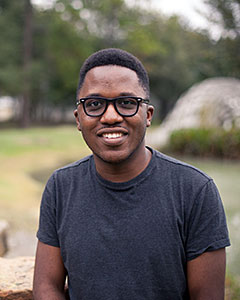 Large igneous provinces (LIPs) are among the most influential drivers of global Earth system changes. These massive volcanic events are linked to extreme climate and ocean conditions, increasing global temperatures, ocean acidification, and widespread marine anoxia. Their emplacement and CO2 release frequently align with some of Earth’s most rapid environmental shifts, including four of the five major mass extinctions—most notably the End-Permian extinction, the largest of the Big Five—highlighting their critical role in past Earth systems transitions. However, studying LIPs—particularly submarine ones—remains challenging, as much of their eruptive material is buried beneath the ocean or has been subducted over time. Consequently, much of our understanding of these events has often relied on sedimentary geochemical proxies. These proxies, including osmium isotopes, mercury concentrations, and carbonate dissolution patterns, have become essential tools for reconstructing LIP emplacement and assessing its impact on the global carbon cycle. They also help establish the timing and intensity of volcanic activity in relation to major climate events.
Large igneous provinces (LIPs) are among the most influential drivers of global Earth system changes. These massive volcanic events are linked to extreme climate and ocean conditions, increasing global temperatures, ocean acidification, and widespread marine anoxia. Their emplacement and CO2 release frequently align with some of Earth’s most rapid environmental shifts, including four of the five major mass extinctions—most notably the End-Permian extinction, the largest of the Big Five—highlighting their critical role in past Earth systems transitions. However, studying LIPs—particularly submarine ones—remains challenging, as much of their eruptive material is buried beneath the ocean or has been subducted over time. Consequently, much of our understanding of these events has often relied on sedimentary geochemical proxies. These proxies, including osmium isotopes, mercury concentrations, and carbonate dissolution patterns, have become essential tools for reconstructing LIP emplacement and assessing its impact on the global carbon cycle. They also help establish the timing and intensity of volcanic activity in relation to major climate events.
Scientific ocean drilling has been instrumental in advancing our understanding of LIP-driven environmental change by providing high-resolution sedimentary records from major ocean basins. These records have helped establish spatial and temporal constraints, revealing direct links between LIPs and dramatic climate and ecological disruptions.
In this lecture, I will present findings from multiple IODP expeditions that illustrate the connections between large-scale volcanism, rapid climate shifts, and global biogeochemical cycling. I will discuss new insights into OAE 1a and the Ontong Java Plateau from ODP Leg 198, and explore the influence of LIPs on the Miocene Climatic Optimum using records from ODP Leg 165. Additionally, I will highlight proxy calibration efforts using sediments recovered from IODP Expedition 397. By integrating these records, I will demonstrate how LIPs have shaped past environmental change and explore their broader implications for Earth’s present and future climate dynamics.
Dr. Lucien Nana Yobo is an Assistant Professor in the Department of Geology & Geophysics at Texas A&M University. His research focuses on the application of metal isotopes on multiple aspects of biogeochemistry of past Earth system perturbations, including fingerprinting the effects of large igneous provinces and their extreme environmental impacts. He has participated in two IODP expeditions, sailing on Expedition 397 and a shore base participant on Expedition 392. He completed his Ph.D. from the University of Houston, following undergraduate studies at California State University-Fresno and graduate work at the University of Nebraska-Lincoln.
A MICROFOSSIL HISTORY FROM THE BOTTOM OF THE SEA: SHARKS, FISH, MASS EXTINCTIONS, AND 85 MILLION YEARS OF GLOBAL CHANGE
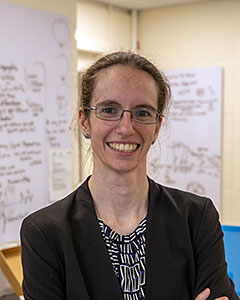 Fish are the most diverse group of vertebrates on the planet today, and the type and abundance of fish present in the marine ecosystem depend on the environmental conditions and food web processes in that region. Further, fisheries and fish-centric eco-tourism support multi-hundred billion dollar industries, and fish are a significant source of protein for much of the world’s population. Yet our understanding of the development of this spectacular biodiversity, and how fish respond to changes in climate, habitat, and environment, is limited due to their sparse body fossil record. Ichthyoliths—isolated microfossil fish teeth and shark scales—are the most numerous vertebrate fossils known, and preserve a unique history of the abundance, community composition, and evolutionary history of fish and sharks. While most scientific ocean drilling research has focused on paleoclimate reconstructions and plankton evolution, ichthyoliths preserved in these sediments can provide a unique snapshot into the evolutionary and ecological history of marine predators. In this talk, I draw on the 55+ year legacy of interdisciplinary and collaborative foundational work supported by scientific ocean drilling and use ichthyoliths preserved in deep-sea sediments to explore how open-ocean fish and sharks respond to Cretaceous and Cenozoic global change, from mass extinctions to rapid climate change events, and discuss how these upper trophic level marine vertebrates interact with the dynamic earth system.
Fish are the most diverse group of vertebrates on the planet today, and the type and abundance of fish present in the marine ecosystem depend on the environmental conditions and food web processes in that region. Further, fisheries and fish-centric eco-tourism support multi-hundred billion dollar industries, and fish are a significant source of protein for much of the world’s population. Yet our understanding of the development of this spectacular biodiversity, and how fish respond to changes in climate, habitat, and environment, is limited due to their sparse body fossil record. Ichthyoliths—isolated microfossil fish teeth and shark scales—are the most numerous vertebrate fossils known, and preserve a unique history of the abundance, community composition, and evolutionary history of fish and sharks. While most scientific ocean drilling research has focused on paleoclimate reconstructions and plankton evolution, ichthyoliths preserved in these sediments can provide a unique snapshot into the evolutionary and ecological history of marine predators. In this talk, I draw on the 55+ year legacy of interdisciplinary and collaborative foundational work supported by scientific ocean drilling and use ichthyoliths preserved in deep-sea sediments to explore how open-ocean fish and sharks respond to Cretaceous and Cenozoic global change, from mass extinctions to rapid climate change events, and discuss how these upper trophic level marine vertebrates interact with the dynamic earth system.
Dr. Elizabeth Sibert sailed on JOIDES Resolution Expedition 378 and is an Assistant Scientist at Woods Hole Oceanographic Institution. Her research lies at the intersection of biological oceanography and paleobiology, investigating how marine ecosystems, and particularly fish and sharks, interact with global change on short and long timescales, reconstructing ancient marine community dynamics using microfossil fish teeth and shark scales preserved in deep sea sediments. Elizabeth received her B.S. in Biology from UC San Diego, and her M.S. and Ph.D. in Biological Oceanography from Scripps Institution of Oceanography. Following her Ph.D., she was a Junior Fellow in the Harvard Society of Fellows at Harvard University. She subsequently held positions as a Hutchinson Fellow and Associate Research Scientist at Yale University before moving to Woods Hole Oceanographic Institution as an Assistant Scientist, where she is thrilled to support the Paleo-FISHES lab. In addition to her oceanographic research, Elizabeth is passionate about improving access to STEM research to folks with disabilities through research opportunities, career development, and outreach efforts. In her spare time, Elizabeth is a professional-level circus artist and coach, a skill set she has been refining for over 20 years.
Ocean Discovery Lecturer Specifications
- Six Ocean Discovery Lecturers are chosen for each academic year.
- Each Ocean Discovery Lecturer is requiredto give six lectures during the academic year. Due to the popularity of the program, many lecturers, however, agree to give more.
- The lecture topic should focus on results of IODP research. Synthesis lectures on broad topics associated with IODP’s scientific objectives (environmental change, processes, and effects; climate change; deep biosphere and the subseafloor ocean; and solid Earth cycles and geodynamics) are strongly encouraged.
- Lectures should be aimed at a broad geoscience audiences consisting primarily of graduate and undergraduate students and the scientifically literate public.
- USSSP will fund the speaker’s transportation expenses to and from each institution; host institutions will provide housing, meals, and local transportation for the speaker.
- After completion of the required lectures, USSSP will provide a small honorarium for the speaker’s participation.
Host A Lecture
Apply to host a 2025-2026 Ocean Discovery Lecturer by completing this form no later than May 2, 2025.
Previous Distinguished Lecturers
The Ocean Discovery Lecturers for the 2024-2025 academic year are:
LIFE IN THE MARINE CRUSTAL BIOSPHERE
The oceanic crust, located often below a thick layer of sediment, is one of Earth’s most remote habitats. The permeable basement rock hosts a dynamic aquifer, where water isolated from the sea above can circulate. Microorganisms in this crustal biosphere are deprived of sunlight and the planet’s typical food web. Instead, the organisms depend on the minerals and nutrients of the subseafloor aquifer. There is much to learn from these organisms, including their contributions to global biogeochemical cycles and their strategies for surviving in their nutrient and energy-limited habitat. For 27 years, the international ocean drilling community has studied this environment—and the microorganisms living within—using subseafloor borehole observatories. Because the lifestyles of these microorganisms are different from those at the surface, cultivation has been mostly unsuccessful. Thus, much of what we know about these elusive organisms results from genomic analyses. This presentation is an introduction to the borehole observatories of the Juan de Fuca Ridge Flank and our genomic understanding of the unique but abundant microorganisms of the marine crust.
Stephanie is an associate professor of the biology department at Hartwick College in Oneonta, NY. Her research focuses on subsurface microbiology. Stephanie earned a BS in biochemistry from Hartwick College and a PhD in geochemistry from the Colorado School of Mines, studying the microbiology of Antarctic sediments. As an NSF-funded post-doc, Stephanie worked at the Bigelow Laboratory for Ocean Science, investigating genomes of the Juan de Fuca Ridge crustal aquifer. In total, she has spent a total of 166 days at sea, participating in IODP expeditions 318, 365, and other expeditions to the IODP observatories (Juan de Fuca Ridge and North Pond). Stephanie is thrilled to be back at her alma mater, and takes great pride in exposing undergraduate students to collaborative research projects.
Lecture Schedule
- September 19, 2024 — Bigelow Laboratory for Ocean Sciences, East Boothbay, ME
- October 11, 2024 — Colorado School of Mines, Golden, CO
- October 14, 2024 — University of California Riverside, Riverside, CA
- November 12, 2024 — Southwestern Oregon Community College, Coos Bay, OR
- November 14, 2024 — Texas A&M University Galveston, Galveston, TX
- March 28, 2025 — Appalachian State University, Boone, NC
THE CHURNING INTERIOR OF PLANET EARTH—
A VIEW OF THE PACIFIC OVER THE CENOZOIC
For the last 50 years, plate tectonics has proven to be an extraordinarily successful framework for understanding processes near the surface, from earthquakes and volcanoes to sea floor spreading and long-term sea level change. Despite its kinematic success, uncovering the underlying dynamics and linkage of plate tectonics to the deeper mantle has proven to be more elusive. This is exemplified by our poor understanding of the time-dependence of plate tectonics, like the formation of new plate boundaries, changes in plate direction, and a supercontinent cycle. This lecture will detail key research breakthroughs that span different disciplines from ocean drilling to global seismology, computational science, and earth physics to elucidate the forces driving plate tectonics.
Ocean drilling has provided some of the key constraints, including within the Pacific hemisphere, showing a drastic change in plate tectonics and mantle convection during the Eocene. This is exemplified by the prominent bend in the Hawaiian–Emperor seamount chain which apparently indicates that the Pacific Plate abruptly changed its direction from the north to the west. The Izu-Bonin-Mariana (IBM) subduction zone, south of Japan, and the Tonga-Kermadec, north of New Zealand, formed at roughly the same time and the change in Pacific Plate motion has been linked with the initiation of these vast subduction systems pulling the Pacific to the west. I shed new light on this topic by describing results from IODP Expeditions 351 and 352 to IBM and 371 to Zealandia within the context of a new generation of global models that realistically treat the mechanics of subduction and plate tectonics. Both an abrupt Pacific Plate motion change and a change in mantle plume dynamics have been proposed to account for the Hawaiian–Emperor Bend, but by integrating the historical constraints into plate reconstructions and high-resolution global dynamic models we are better able to understand the mechanics of plate tectonics and its coupling to the deeper interior.
Michael Gurnis is the John E. and Hazel S. Smits Professor of Geophysics at the California Institute of Technology since 1994. Joining the scientific ocean drilling community late in his career, he has sailed on three IODP expeditions to the Indian and Pacific Oceans since 2014, after many years working to advance computational studies of solid earth processes. Mike wears different hats, including as Director of the Seismological Laboratory at Caltech.
Lecture Schedule
- October 16, 2024 — Chapman University, Orange, CA
- October 23, 2024 — Kansas State University, Manhattan, KS
- October 25, 2024 — Purdue University, West Lafayette, IN
- November 1, 2024 — University of Wisconsin-Madison, Madison, WI
- November 14, 2024 — Colorado State University, Fort Collins, CO
- April 7, 2025 — University of Nevada, Reno, NV
- April 9, 2025 — Queens College, CUNY, Queens, NY
- April 10, 2025 — University of New Hampshire, Durham, NH
EMBRACE DIAGENESIS: THE ROLE OF METHANE IN CARBON AND SULFUR SEQUESTRATION IN MARINE SEDIMENTS
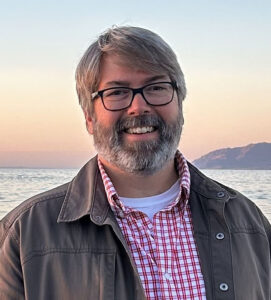 In marine sediments, authigenic minerals, formed after deposition of the sediments, serve as geological archives of paleo-pore water conditions that reflect changing environmental conditions through time. Globally, the presence of organic carbon and seawater sulfate in near-seafloor marine sediments drives organoclastic sulfate reduction (OSR), increasing alkalinity and sulfide species in the porewaters and resulting in pyrite and authigenic carbonate formation in marine sediments. These precipitates are a common occurrence in modern organic carbon bearing marine sediments and are observed in outcrops of ancient black shale sequences on land. Below the sulfate reduction zone, organic carbon drives methanogenesis in marine sediments and at the boundary of sulfate and methane depletion, known as the sulfate-methane transition zone (SMTZ), additional alkalinity and sulfide production is driven by the anaerobic oxidation of methane (AOM). This can result in additional authigenic carbonate and pyrite formation beyond that produced by OSR. The depth of the SMTZ is controlled by the availability of organic carbon, sulfate, and methane and is largely driven by changes in sedimentation rate and/or changes in the flux of methane. Through time, the result is a moving geochemical front (the SMTZ) that leaves a wake of authigenic mineralization in its path, overprinting, cementing, or replacing the originally deposited primary minerals, rock fragments, and biogenic particles. Methane seeps represent one end member environment where the SMTZ exists at or near the seafloor, whereas in methane-limited systems, OSR dominates and the SMTZ exists at greater depths.
In marine sediments, authigenic minerals, formed after deposition of the sediments, serve as geological archives of paleo-pore water conditions that reflect changing environmental conditions through time. Globally, the presence of organic carbon and seawater sulfate in near-seafloor marine sediments drives organoclastic sulfate reduction (OSR), increasing alkalinity and sulfide species in the porewaters and resulting in pyrite and authigenic carbonate formation in marine sediments. These precipitates are a common occurrence in modern organic carbon bearing marine sediments and are observed in outcrops of ancient black shale sequences on land. Below the sulfate reduction zone, organic carbon drives methanogenesis in marine sediments and at the boundary of sulfate and methane depletion, known as the sulfate-methane transition zone (SMTZ), additional alkalinity and sulfide production is driven by the anaerobic oxidation of methane (AOM). This can result in additional authigenic carbonate and pyrite formation beyond that produced by OSR. The depth of the SMTZ is controlled by the availability of organic carbon, sulfate, and methane and is largely driven by changes in sedimentation rate and/or changes in the flux of methane. Through time, the result is a moving geochemical front (the SMTZ) that leaves a wake of authigenic mineralization in its path, overprinting, cementing, or replacing the originally deposited primary minerals, rock fragments, and biogenic particles. Methane seeps represent one end member environment where the SMTZ exists at or near the seafloor, whereas in methane-limited systems, OSR dominates and the SMTZ exists at greater depths.
Carbonate and sulfide authigenic minerals are often a nuisance to paleoceanographers and sedimentologists who seek to reconstruct original sea surface, water column, and sea floor conditions through time, but they are also the manifestation of paleo-pore fluid reactions through time, which can help us all reconstruct carbon and sulfur transformations, their sequestration in marine sediments, and the broader mechanisms that drive shallow subseafloor diagenesis through time.
In this talk, I will review early diagenetic processes in marine sediments and use scientific ocean drilling data from ODP Leg 204 (Cascadia), NGHP-01 (India), IODP Exp. 386 (Japan), and UT-GOM2-1 and -2 (Gulf of Mexico) to reveal a range of processes that can be examined through the detailed integration of pore fluid geochemistry, sedimentology, and physical properties data. The results emphasize the important role of methane in marine sediments, both as a driver for geochemical processes and a respondent to changing environmental conditions.
Dr. Joel E. Johnson, Professor and Chair in the Department of Earth Sciences at the University of New Hampshire, received his B.S. from the University of Minnesota, Duluth, his M.S. from the University of Illinois, and his Ph.D. from Oregon State University. Joel was a post-doctoral fellow at the Monterey Bay Aquarium Research Institute and joined the University of New Hampshire as an Assistant Professor in the Department of Earth Sciences in 2005. His research is focused broadly on the geologic interpretation of recent marine sedimentary sequences in order to reconstruct the geologic, geochemical (diagenetic), tectonic, and oceanographic processes that occur and interact during the evolution of continental margins. In most of his recent research projects, these reconstructions have been used to understand marine methane cycling and the evolution of methane hydrate systems through time. Joel has experience as a shipboard sedimentologist on four scientific ocean drilling expeditions and has coring, seafloor mapping, and seismic data acquisition experience on 20 research cruises. He has also twice taught a short course for IODP on shipboard sedimentology. Joel routinely works with international science teams from data collection to follow-up laboratory measurements and integrated synthesis. His publications range in spatial scale from sediment grain studies to plate boundary tectonics and timescales of modern to tens of millions of years. At UNH Joel teaches undergraduate and graduate courses in geological oceanography, sedimentology, structural geology, and geotectonics.
Lecture Schedule
- October 3, 2024 — Oregon State University, Corvallis, OR
- November 21, 2024 — University of Florida, Gainesville, FL
- January 31, 2025 — Kent State University, Kent, OH
- February 14, 2025 — University of Iowa, Iowa City, IA
- February 19, 2025 — Chesapeake Biological Laboratory, Solomons, MD
- March 27, 2025 — University of Kentucky, Lexington, KY
- April 18, 2025 — Northern Illinois University, DeKalb, IL
IODP DRILLING YIELDS EXCITING INSIGHTS INTO THE WORKINGS OF A YOUNG, OBLIQUELY RIFTED, ACTIVE CONTINENTAL MARGIN
The Gulf of California (GOC) marks a young transtensional plate boundary in western Mexico between the North American and Pacific plates. Obliquely rifted continental margins such as this are rare today, but thought to have been more common in the past—for example, during the Mesozoic development of the Atlantic Ocean. Study of the older margins is hindered by subsidence and thick sediment cover, so less sedimented GOC basins are more accessible analogues. Deep sea exploration through scientific ocean drilling in the GOC has focused in the centrally located Guaymas Basin, first in 1978 on the Glomar Challenger during Deep Sea Drilling Project (DSDP) Leg 64 and later in 2019 on the JOIDES Resolution during International Ocean Discovery Program (IODP) Expedition 385. In this basin, seafloor spreading is manifested in surficial graben and subsurface sills developed in the sediment fill. Leg 64 was renowned for recovering the first ~150 m of hydraulically-piston-cored (HPC) sediment at Site 480 on the Sonoran slope. Forty years later, Expedition 385 scientists marveled at the same fine mm-scale lamination preserved in HPC-cored biosiliceous sediment fill of the basin. Sites drilled during DSDP Leg 64 on the northern continental slope as well as across the northern and southern grabens were augmented during Expedition 385 by a series of eight sites (~4 km of recovered core). They link north to south and expand east to west—far from the spreading center—providing a broader picture of basin sedimentation and off-axis magmatism. This deeper and more extensive view provides new insights into the nature and distribution of sedimentary facies and volcanism in the basin, including sill-sediment contact zones and gravity-mass flow deposits. Such event beds warrant further study, as they are potentially linked to seismic and storm processes acting across the narrow confines of the Gulf of California. I will present a broad overview of the basin and its workings through the lens of shipboard discoveries and post-cruise research, including that of my students and colleagues. These studies might suggest that Guaymas is the “Goldilocks” Basin of the Gulf of California: you decide if it is just right or too much of a good thing!
Kathie Marsaglia is a Professor of Geology in the Department of Geological Sciences, California State University Northridge (CSUN), her academic home since 2000. She is a sedimentologist with expertise in sandstone petrology, sedimentation and tectonics, as well as marine geology. Between graduate degrees and before coming to CSUN, she worked in the petroleum industry in exploration and as a senior reservoir geologist. Her dissertation on magmatic-arc sand provenance was based on samples collected from ~80 DSDP sites stored in the Scripps and Lamont-Doherty core repositories. Her participation in Ocean Drilling Program (ODP) Leg 126 to the Izu-Bonin Arc near the end of her PhD was transformative. Over her career she has spent about two years at sea on 14 scientific cruises, including 6 ODP and 4 IODP, collecting, describing, and interpreting marine sediments and sedimentary rocks in the circum-Pacific and Northern Atlantic Oceans and the western Mediterranean Sea. These cruises covered a wide range of tectonic and oceanographic settings: intraoceanic arc, reararc, backarc, triple junction, passive continental margin, oceanic plateau, and obliquely rifted margin (Exp 385). She transferred expertise gained on these cruises into four IODP Technical Notes on core description and smear slide analysis (https://iodp.tamu.edu/publications/TN.html). She is a Fellow of the Geological Society of America, was an AAPG Distinguished Lecturer, and received the Grover E. Murray Distinguished Educator Award from AAPG and Outstanding Faculty Award from CSUN. Service to ODP and IODP includes various proposal evaluation panels, membership on the JOIDES Resolution Readiness Assessment Team and U.S. Advisory Committee (USAC), and most recently serving as Science Co-Chair of the IODP Science Evaluation Panel (2022–2024).
Lecture Schedule
- September 12 – 13, 2024 — University of Minnesota, Minneapolis, MN
- September 16, 2024 — University of Iowa, Iowa City, IA
- October 2, 2024 — University of California Davis, Davis, CA
- October 11, 2024 — University of Connecticut, Storrs, CT
- October 18, 2024 — State University of New York Binghamton, Binghamton, NY
- October 21, 2024 — New Mexico Institute of Mining and Technology, Socorro, NM
- November 14, 2024 — University of Louisiana Lafayette, Lafayette, LA
- November 21, 2024 — California State University Fresno, Fresno, CA
CATCHMENT SENSITIVITIES OF THE WEST AND EAST ANTARCTIC ICE SHEETS TO ORBITAL FORCING DURING THE MID- TO LATE PLIOCENE
The Antarctic ice sheet appears as a large, massive homogenous blob on most maps, yet some computer models predict there is considerable variability with respect to how the ice sheet may change under various warming scenarios due to different Earth systems processes. Sediment records recovered from the ice margin during ocean drilling expeditions associated with the International Ocean Discovery Program (IODP) and its predecessor programs can help provide some insight on the causes of Antarctic ice sheet variability. Such insight is fundamental towards understanding some of the sensitivities of how the ice sheet might respond to future climate change.
Geochemical records from the deep, which reflect past changes in ice volume and global temperature, demonstrate clear oscillations in ice volume that were paced by astronomical variations. Such astronomical variations involve eccentricity (the shape of Earth’s orbit, ~400 and 100 thousand year cycles, kyr), obliquity (tilt of Earth’s axis, ~41 kyr), and precession (wobble of Earth’s axis, ~20 kyr) cycles. While geological records recovered from the Antarctic margin also demonstrate this, the exact mechanisms for how orbital forcing impacts ice sheet mass balance, including regional sensitivities of ice sheets to marine and terrestrial climate feedbacks, remain elusive. I will present two high-resolution mid-Pliocene to Early Pleistocene (~3.3 to 2.3 Ma) records of iceberg-rafted debris recovered from the West Antarctic Ice Sheet (WAIS) Ross Sea margin and the East Antarctic Ice Sheet (EAIS) Wilkes Land margin collected during IODP Expeditions 374 and 318, respectively. These results suggest that different sectors of marine-based margins of Antarctica’s ice sheets have different sensitivities to various climate and oceanic feedbacks resulting from astronomical variations. Our findings ground-truth computer modelling experiments that highlight large spatial variability in the response of Antarctica’s ice sheet to future warming, and that sensitivities of the ice sheet to atmospheric and marine forcing differ in each catchment.
Dr. Molly Patterson is an Associate Professor in the Department of Earth Sciences at Binghamton University in New York. Much of her career has been driven by a keen interest in better understanding the interactions between the Southern Ocean and the Antarctic Ice Sheet and its downstream influence on the global ocean. This interest began as an undergraduate researcher, when she examined diatoms from Holocene Southern Ocean records while undertaking a B.A. in Geology at Colgate University. Her M.S. thesis at Southern Illinois University of Carbondale focused on examination of foraminifera assemblages from the Antarctic DRILLing Project (ANDRILL) Southern McMurdo Sound Project (AND-2A). Her M.S. experience introduced her to working with large international science teams. She then conducted a Ph.D. at Victoria University of Wellington with researchers in the Antarctic Research Centre in New Zealand. As a Ph.D. student she was first exposed to the ocean drilling program as a part of her thesis work, which involved both legacy core material recovered adjacent to New Zealand, as well as newly recovered material from the Wilkes Land Margin of Antarctica associated with IODP Expedition 318. As a post-doctoral researcher at the University of Massachusetts Amherst, she developed a strong interest in better understanding the connections between Northern Hemisphere and Southern Hemisphere climate systems working with the Lake El’gygytgyn group there. Molly has participated as a shipboard scientist on IODP Exp. 374 to the Ross Sea. She has also served as a panelist on the IODP Science Evaluation Panel (SEP).
Lecture Schedule
- October 25, 2024 — Calvin University, Grand Rapids, MI
- November 1, 2024 — University of California Santa Cruz, Santa Cruz, CA
- February 19, 2025 — Wesleyan University, Middletown, CT
- February 20-21, 2025 — George Mason University, Fairfax, VA
- February 28, 2025 — University of Massachusetts Amherst, Amherst, MA
- March 21, 2025 — Virginia Tech, Blacksburg, VA
- March 28, 2025 — Indiana University of Pennsylvania, Indiana, PA
- April 11, 2025 — The University of Texas at Austin, Austin, TX
MEGATHRUST… OR BUST? THE SAGA OF THE IODP NanTroSEIZE SUBDUCTION ZONE ULTRADEEP DRILLING PROJECT
IODP was launched two decades ago with the grand challenge of drilling, sampling, and instrumenting a subduction zone plate boundary fault – a “megathrust” – at a depth where earthquakes occur. Subduction zones produce all of the truly giant earthquakes on our planet, accompanied too often by devastating tsunamis. The launch of the riser drillship Chikyu gave IODP new ultra-deep drilling capability for the first time. The Nankai Trough Seismogenic Zone Experiment (NanTroSEIZE) was conceived to use this new capacity to its fullest by drilling a comprehensive transect spanning the leading edge of that SW Japan subduction zone, known to host repeated magnitude 8+ earthquakes and tsunamis, sampling and instrumenting the incoming plate, the shallow frontal fault zones, and ultimately the main megathrust fault at up to five thousand meters below the seafloor. Over 13 years and 13 expeditions, 15 sites were drilled, three of which now have long-term borehole monitoring instruments connected to offshore fiber optic cables, making for the first truly real-time subseafloor observatories in ocean drilling history. The main borehole is the deepest ever in scientific ocean drilling at more than 3000 meters below the seafloor. The results of the NanTroSEIZE effort have revolutionized our understanding of how these subduction faults work, how stress builds up in the earth and is released, and how continental margin accretionary wedges grow, yielding many surprises along the way. And yet the greatest objective remains elusive: Expedition 358, the last of the NanTroSEIZE expeditions in IODP, was not able to overcome technical challenges and advance the borehole the final 2000 meters to the main fault zone. This presentation will highlight the groundbreaking science achieved as well as the setbacks and frustrations of high-risk scientific exploration, ending with a look at the unprecedented insight we are still getting today from this “wired” plate boundary.
Harold Tobin is Professor of Earth and Space Sciences at the University of Washington, where he holds the Paros Chair in Seismology and Geohazards. Between 1992 and 2019 he sailed as a shipboard scientist on ten ODP and IODP drilling expeditions, serving as co-Chief Scientist four times while leading the multi-expedition Nankai Trough Seismogenic Zone Experiment project for over a decade. Tobin has spent over 500 days at sea. His career research focus has been on the structure, mechanics, and physical properties of plate boundary faults, including study of the Cascadia, Costa Rica, Barbados, and Nankai subduction zones, as well as the San Andreas fault of California and the Alpine fault of New Zealand. He holds a bachelor’s degree from Yale University and a doctorate from University of California Santa Cruz, followed by postdoctoral research at Stanford University. Prior to moving to the University of Washington in 2018, he held faculty positions at the University of Wisconsin and at New Mexico Tech. Tobin is currently the Director of the Pacific Northwest Seismic Network and the Washington State Seismologist.
Lecture Schedule
- October 7, 2024 — San Jose State University, San Jose, CA
- February 3, 2025 — Utah State University, Logan, UT
- February 26, 2025 — Northern Arizona University, Flagstaff, AZ
- March 6-7, 2025 — University of Alaska Fairbanks, Fairbanks, AK
- March 31, 2025 — Boise State University, Boise, ID
- April 3, 2025 — Michigan State University, East Lansing, MI
- April 11, 2025 — University of Nebraska-Lincoln, Lincoln, NE
Information on previous Ocean Discovery Distinguished Lecturers can be found here.


